Capital projects are inherently high-risk endeavors. As a client-side project manager, you're likely familiar with the disruptions that can occur—whether they be project delays, budget overruns, or sudden shifts in market conditions. These risks can derail even the most meticulously planned project.
A risk assessment matrix is an essential tool for managing these uncertainties. It helps you evaluate and prioritize risks, enabling proactive, informed decision-making that safeguards your project's timeline, budget, and overall success.
This guide will help you create a risk matrix and understand the nuances of different matrix structures to ensure you choose the right one for your project.
What is a Risk Assessment Matrix?
A risk assessment matrix, sometimes called a risk management matrix, is a visual tool used to assess and prioritize risks by evaluating their likelihood and potential impact on your project.

Displayed as a grid, the matrix categorizes risks based on severity—typically with likelihood on one axis and impact on the other. This allows project teams to quickly assess risks and assign them a risk score, which guides the allocation of resources and management efforts.
What is Included in a Risk Assessment Matrix?
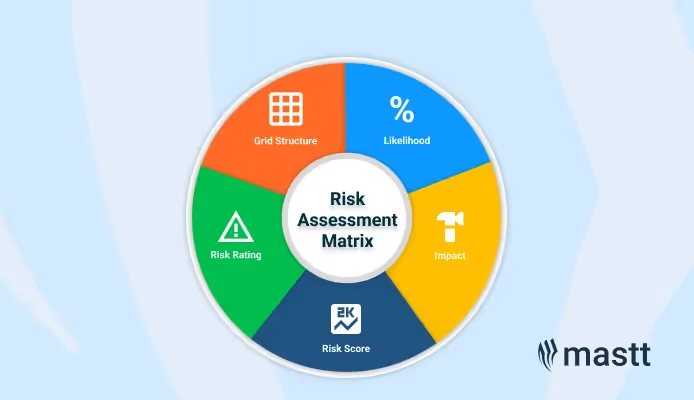
Each risk assessment matrix consists of several crucial components determining its effectiveness in evaluating project risks. These components include:
- Grid Structure: The matrix is typically structured as a grid, with likelihood on one axis and impact on the other. The grid's size can vary based on project complexity and risk governance, ranging from 3x3, 4x4, and 5x5 to even custom arrangements to suit specific project needs.
- Likelihood: This component assesses the probability that a risk event will occur. Understanding the likelihood helps determine how probable a particular risk will materialize during the project lifecycle.
- Impact: This refers to the potential consequences of a risk event if it does occur. The impact assessment helps understand the severity of the risk's effects on the project.
- Risk Score: The risk score is derived by multiplying the likelihood and impact values. This numerical score allows project managers to prioritize risks based on their severity and the level of attention they require.
- Risk Rating: This categorizes the risks into various levels of severity (e.g., Very Low, Low, Medium, High, Very High), helping to prioritize management efforts effectively.
The matrix functions as a risk assessment table, providing a clear and organized view of how risks are categorized based on their likelihood and impact.
How to Create a Risk Assessment Matrix
Creating a risk assessment matrix for your construction projects is a structured process that should align with the risk management framework established in your governance plan. This ensures you can effectively evaluate, analyze, and manage risks throughout the project lifecycle. Here's a step-by-step guide to building a highly effective matrix:
1. Utilize a Template and Leverage Previous Documentation
Begin using a standardized template to ensure a consistent structure for your risk assessment matrix, capturing all necessary details while adhering to your risk management plan.
To streamline the process, request that the project team gather risk assessment matrices from similar projects, lessons learned and other relevant documents. This will aid in identifying and evaluating risks more effectively, ensuring that best practices are incorporated as you develop the matrix for your current project.
Download Now: Free 5x5 Risk Matrix Template.
2. Determine Grid Structure Size
When determining the size of your risk assessment matrix, options typically range from 3x3, 4x4, or 5x5, depending on the complexity of your project and your organization's risk governance. Larger grids like 5x5 offer more detailed assessments, useful for complex projects with multiple variables, while smaller grids, such as 3x3, are often sufficient for simpler projects.
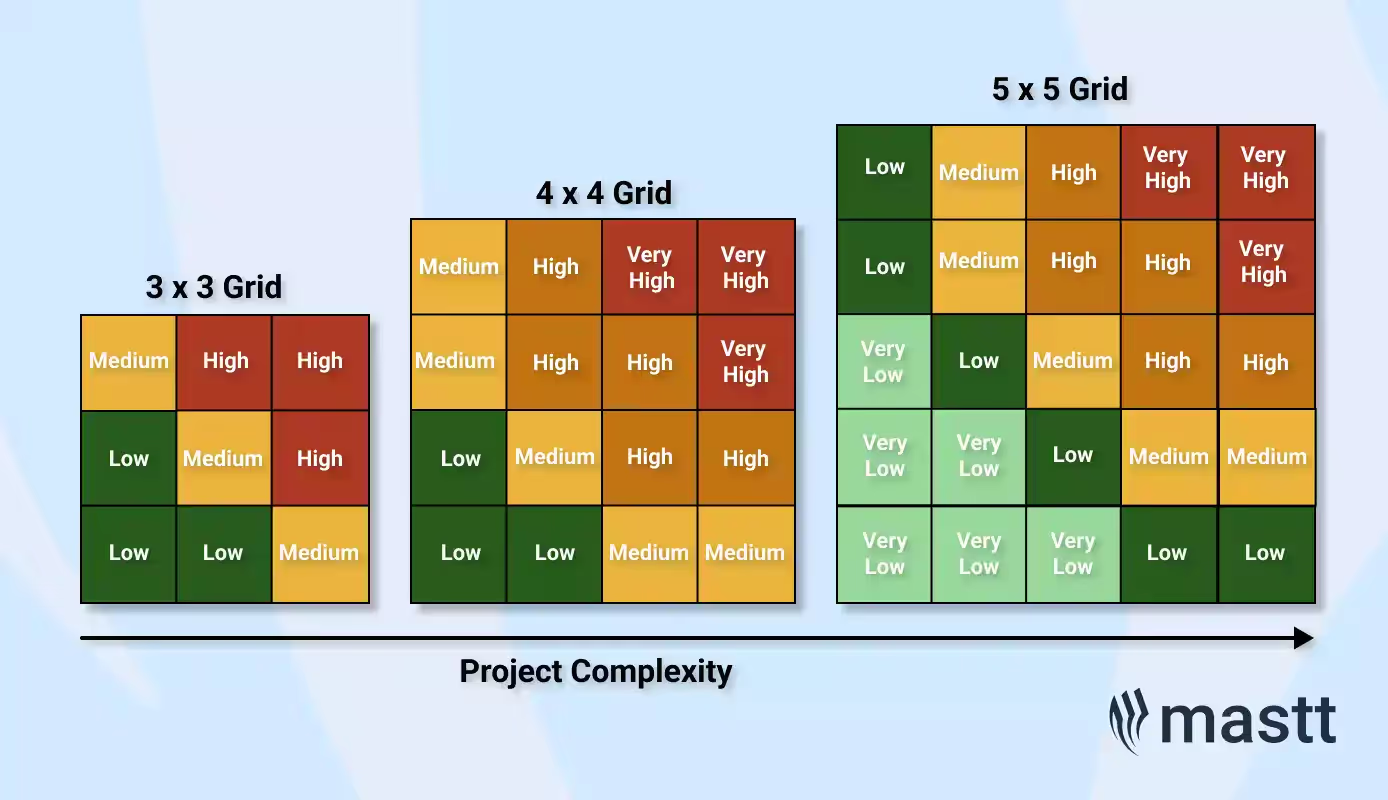
Custom grid sizes can also be tailored to fit unique project needs, ensuring the matrix remains flexible and aligned with your specific risk management strategy.
3. Define Likelihood and Impact Scales
Set numerical scales to measure both the likelihood of risks occurring and the potential impact if they do.
Commonly, we see a 5x5 risk assessment matrix used and recommend the following likelihood and impact scale:
Likelihood
- 1 = Rare
- 2 = Unlikely
- 3 = Possible
- 4 = Likely
- 5 = Almost Certain
Impact
- 1 = Insignificant
- 2 = Minor
- 3 = Moderate
- 4 = Major
- 5 = Catastrophic
These scales provide a structured way to evaluate each risk and allow for easier comparison.
4. Establish Likelihood and Impact Criteria
Define clear criteria for each number on the likelihood and impact scales to ensure consistent risk assessment. For example, specify what constitutes a "catastrophic" impact or an “unlikely” event. Establishing precise definitions helps the project team assess risks using the same governing standards, reducing subjectivity and improving alignment across the project.

5. Establish Risk Tolerance Thresholds
Set risk tolerance thresholds to determine what risks need immediate action and which can be monitored. This step is crucial for guiding decision-making. For instance, risks that exceed a certain score may require mitigation strategies, while lower scores may be considered acceptable or just monitored.
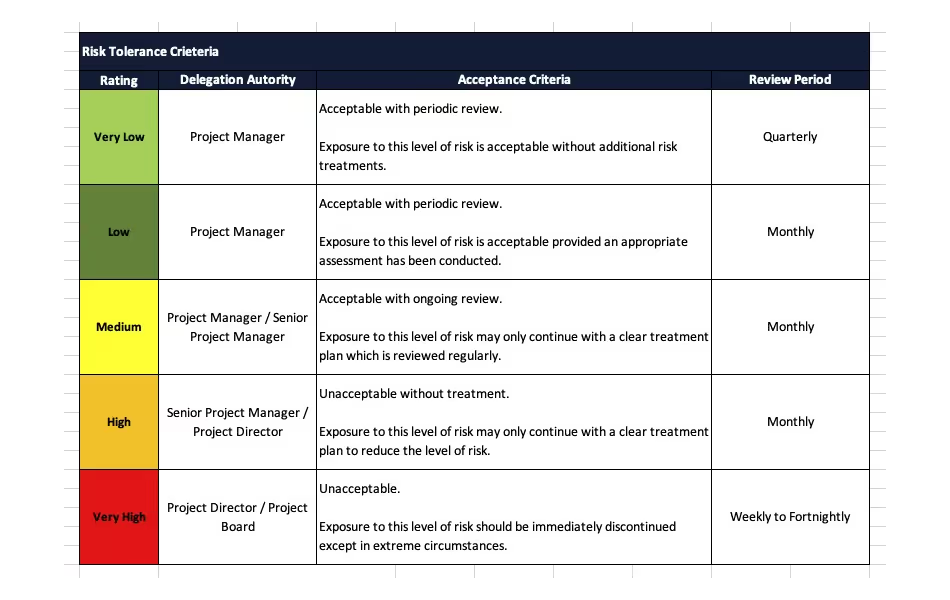
6. Draw the Matrix
Create the matrix by plotting likelihood on one axis and impact on the other. The resulting grid allows you to map risks according to their scores. This visual representation simplifies the process of identifying high-priority risks.
7. Assign Risk Scores
Assign a rating based on the likelihood and impact values for each identified risk. Then, calculate the risk score by multiplying the two.
This score assists with prioritizing risks following assessment, giving you a clear understanding of which ones need immediate attention and which can be monitored.
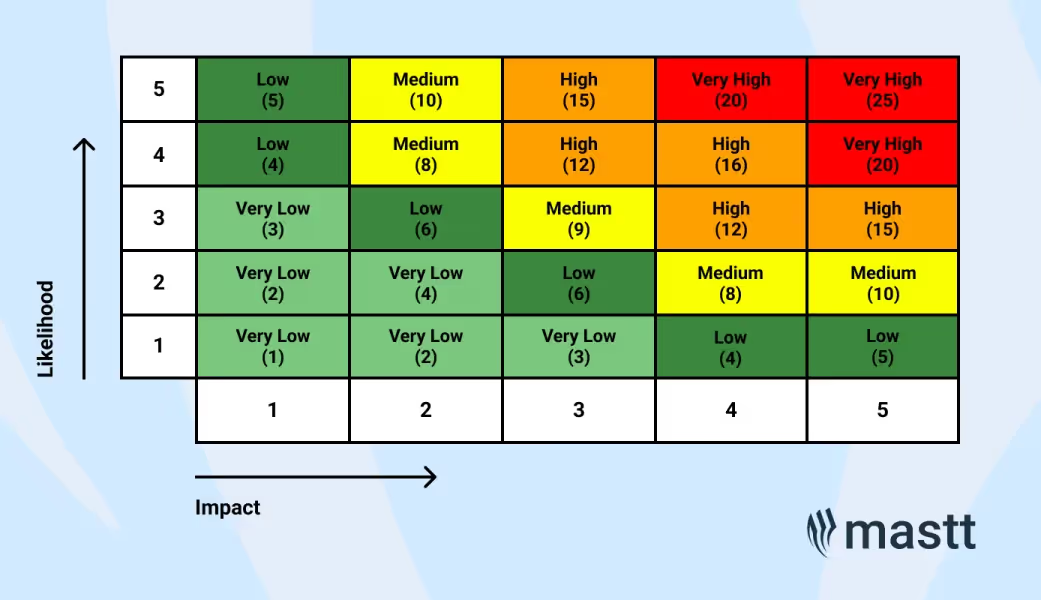
8. Define Risk Ratings
Categorize risks into different risk ratings, such as very low, low, medium, high, and very high. Using color-coding or labels makes it easy to quickly assess and prioritize risks. High-risk items should be addressed with detailed mitigation plans, while low-risk items may require monitoring.
Using the example of a 5x5 risk assessment matrix, we recommend the following combination of risk rating, risk score, and color-coding:
9. Review and Update Regularly
A risk matrix is not a one-time exercise. Be sure to regularly review and update the matrix structure and the assessment criteria to account for new risks or changes to existing ones. This ensures your risk management process remains dynamic and responsive to the project’s evolving needs.
10. Analyze and Prioritize Risks
Finally, analyze the completed matrix to prioritize risks based on their scores. High-priority risks should be addressed immediately, while lower-priority risks can be monitored over time. This step helps ensure your team focuses on the most critical risks first.
Tips on How to Create a Risk Matrix
Now that we've covered the steps involved in creating a risk matrix, what key factors should you keep in mind during this process? Here are some practical tips to help you develop an effective risk assessment matrix.
- Engage Stakeholders Early: Be sure to involve key stakeholders from the start. Their input will help identify potential risks from multiple perspectives, ensuring that your matrix is thorough and reflects the diverse factors that may impact the project.
- Reference Previous Projects: When defining your likelihood and impact scales, use examples from past projects. This speeds up the matrix creation process by giving you a starting point and helps contextualize risk levels, making it easier for the team to apply the matrix in real-time decision-making.
- Use a Template: Consider using a risk assessment matrix template to streamline the process. Templates provide a structured format for plotting risks and ensure consistency throughout the matrix.
- Be Specific with Criteria: Clearly define what each level of likelihood and impact represents. Vague criteria can lead to inconsistent risk evaluations. For example, specify what constitutes a "major" impact in terms of cost, timeline, or scope, ensuring the team is aligned.
- Customize for Your Project: Each project is unique, so customize your matrix structure and scoring system accordingly. For more complex projects, you may need a larger grid or tailored risk categories to capture all relevant risks effectively.
- Keep It Simple: While capturing all relevant risks is essential, avoid making the matrix overly complex. A simpler matrix is easier to use, encourages engagement, and ensures it remains a practical tool for managing risks.
- Revisit Regularly: Risks can evolve throughout the project lifecycle. Regularly reviewing and updating the matrix ensures new risks are addressed, and existing risks are reassessed, keeping your management approach dynamic and responsive.
- Leverage Technology: Integrate your risk matrix with project management tools to automate updates, share data efficiently, and maintain real-time insights across the team.
- Train Your Team: Ensure all team members understand how to use the matrix effectively. Training will improve consistency in risk evaluations and interpretation, leading to better risk management and increased team engagement.

Risk Assessment Matrix Example
To better understand how a risk assessment matrix functions, let’s look at a practical example relevant to construction risk management and explore the differences between a 4x4 risk matrix and a 5x5 risk matrix.
Imagine you are managing a large-scale hospital construction project. Several risks might be identified, such as delays in medical equipment deliveries or unexpected geological formations encountered during construction.
Using a 4x4 Risk Matrix
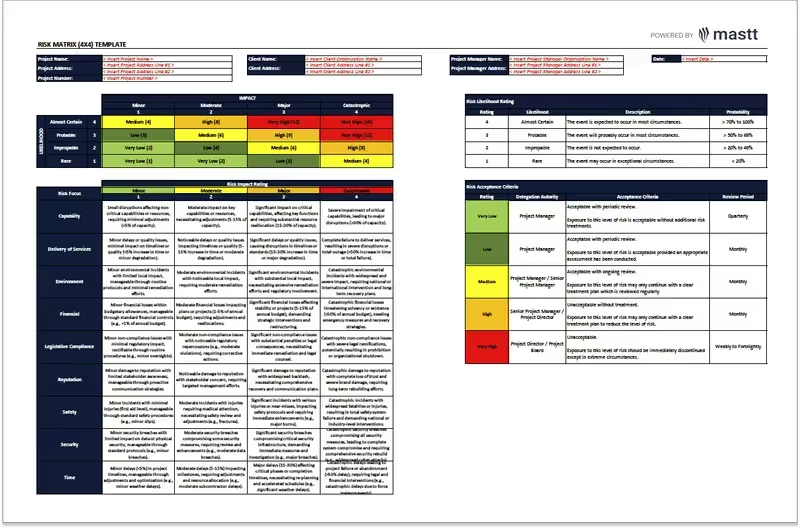
You might opt for a 4x4 risk matrix for smaller projects or preliminary assessments. This matrix is simpler, with fewer categories for likelihood and impact. Here’s how it might be used in your hospital project:
- Likelihood: Equipment delays might be rated as "Possible" (a score of 3 on a 1-4 scale).
- Impact: The impact of these delays on the project timeline might be rated as "Major" (score of 4 on a 1-4 scale).
- Risk Score: By multiplying these scores (3 x 4), you obtain a risk score of 12, placing this risk in the "High" category, which demands attention.
A 4x4 risk matrix is sufficient for smaller projects or those with fewer risks to manage. It allows for quick assessments without the complexity of more detailed matrices.
Using a 5x5 Risk Matrix

For larger, more complex projects—like a hospital construction that involves multiple stakeholders and intricate logistics—a 5x5 risk matrix might be more appropriate. This matrix offers a more detailed analysis, which is crucial for projects where risks need to be meticulously managed. Let’s apply this to the same hospital project:
- Likelihood: Delays in equipment might be rated as "Likely" (score of 4 on a 1-5 scale).
- Impact: The impact of these delays on the project timeline might be rated as "Catastrophic" (score of 5 on a 1-5 scale).
- Risk Score: Multiplying these scores (4 x 5) gives a risk score of 20, which places this risk in the "Very High" category but with finer granularity than the 4x4 matrix.
The 5x5 risk matrix allows for more precise distinctions between risks, making it ideal for complex construction projects where detailed risk management is critical to success. You can refer to our 5x5 Risk Matrix Template for an in-depth understanding.
This example illustrates how using the 4x4 or 5x5 matrix can help project managers prioritize risks effectively, particularly in construction risk management. By methodically assessing each risk's likelihood and impact, you ensure that your project is well-protected against potential setbacks.
Risk Assessment Matrix Template
For ease of use, consider using our 4x4 Risk Matrix Template and 5x5 Risk Matrix Template. These templates help project managers quickly assess and categorize risks, ensuring consistent and accurate risk evaluations.
Building a Strong Risk Assessment Matrix
Building a comprehensive risk assessment matrix is critical to effective risk management in capital projects. By methodically assessing risks and their impacts, you can safeguard your projects against unforeseen challenges and ensure successful completion within scope, time, and budget constraints.
This guide provides a foundational understanding of how to create and use a risk matrix. For more detailed insights and templates, explore our additional resources on construction risk management and project planning.






.avif)








